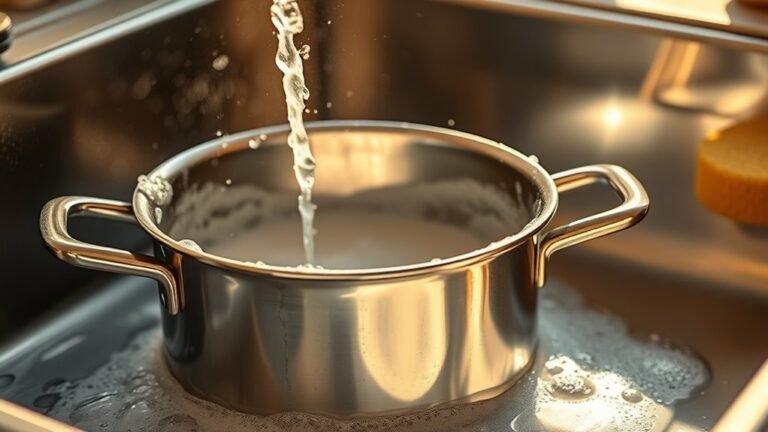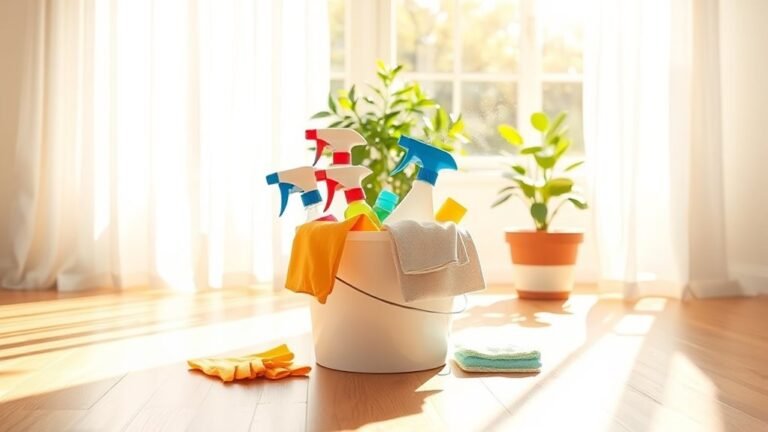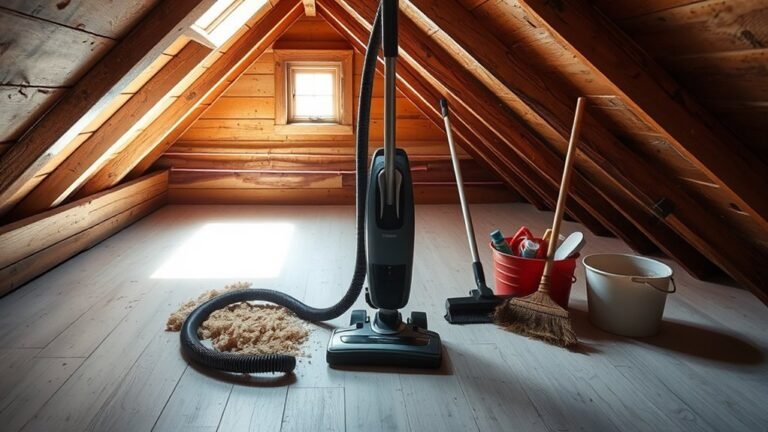How to Remove Stains From Linen Curtains
To remove stains from your linen curtains, first identify the stain type—water stains are pale rings, grease marks feel slick, and organic stains show reddish or brown hues. Gently take down your curtains, blot excess moisture without rubbing, and test a mild detergent or natural solution like vinegar on a hidden spot. Apply your cleaner carefully, wait 10-15 minutes, then rinse and air dry away from sunlight. Follow these steps to keep your linen looking fresh—there’s more to learn about caring for this delicate fabric.
Identifying Different Types of Stains on Linen Curtains

How do you tell one stain from another on your linen curtains? Recognizing stain types is your first step toward effective fabric care. You’ll often spot water stains as pale rings, while grease marks look darker and feel slick. Organic stains like coffee or wine tend to leave deep, reddish or brownish hues. Knowing these differences frees you from guesswork and prevents fabric damage from improper cleaning. You don’t want to treat an oil stain like dirt; that only sets it further. By identifying what you’re dealing with, you gain control over your linen’s upkeep, preserving its natural beauty without relying on harsh chemicals. This knowledge empowers you, keeping your curtains fresh and your home vibrant, just how freedom in fabric care should feel.
Preparing Linen Curtains for Stain Removal
Once you’ve identified the type of stain on your linen curtains, the next step is getting them ready for treatment. Start by gently removing your curtains from the rod to avoid spreading the stain further. Lay them flat on a clean surface and test a small, hidden area for colorfastness—this is essential for effective curtain maintenance. Before applying any stain remover, lightly blot the stained area with a dry cloth to absorb excess moisture or debris. Avoid rubbing, as this can damage the fibers or enlarge the stain. Preparing your curtains properly sets the stage for successful stain removal and supports long-term stain prevention. Taking these steps helps you maintain your curtains’ freedom from damage while preserving their natural beauty and texture.
Using Gentle Cleaning Solutions for Linen Fabric

You’ll want to choose gentle cleaning solutions that protect your linen curtains while effectively removing stains. Mild detergents are great because they clean without damaging the fabric’s fibers. You can also try natural stain removers like vinegar or baking soda for a safe, eco-friendly option.
Mild Detergents Benefits
Choosing the right detergent can make a big difference when cleaning your linen curtains. Mild detergents are your best bet because they protect the fabric’s natural fibers while effectively removing stains. They’re gentle, preserving the integrity and softness of your linen, which means your curtains stay vibrant longer without harsh chemicals breaking them down. Plus, mild detergents support excellent fabric care, helping you maintain your home’s fresh, airy vibe.
| Benefit | Why It Matters |
|---|---|
| Gentle on fibers | Prevents damage and wear |
| Effective cleaning | Removes stains without harshness |
| Maintains color | Keeps curtains looking new |
| Eco-friendly | Safer for you and the planet |
Using mild detergents lets you care for your linen with freedom and confidence.
Natural Stain Removers
Although mild detergents are great, sometimes you need a gentler touch for stubborn stains on your linen curtains. Natural stain removers like a vinegar solution and baking soda can be your best allies. Mix equal parts white vinegar and water to create a gentle yet effective solution. Dab it onto the stain, let it sit for 10 minutes, then blot clean. For tougher spots, sprinkle baking soda directly on the stain, then spray with the vinegar solution. The fizz helps lift dirt without harsh chemicals. Afterward, rinse with cold water and air dry. These natural remedies respect your linen’s delicate fibers and give you freedom from synthetic additives. You’ll keep your curtains fresh and stain-free, all while embracing simple, eco-friendly cleaning.
Step-by-Step Guide to Removing Common Stains
Removing common stains from linen curtains can be straightforward if you follow the right steps. First, identify the stain types—whether it’s coffee, grease, or ink—as each needs a specific cleaning technique. Start by gently blotting the stain with a clean cloth to avoid spreading it. Next, apply a natural stain remover suitable for the stain type, like lemon juice for rust or baking soda paste for grease. Let it sit for 10-15 minutes, then rinse with cold water. For tougher stains, you might need to repeat the process. Always test your cleaning technique on a hidden area first to protect your curtains. With these steps, you’ll keep your linen curtains fresh and stain-free without losing that feeling of freedom in your space.
Tips for Drying and Ironing Linen Curtains Safely

Once your linen curtains are clean, you’ll want to dry and iron them carefully to maintain their texture and shape. Start with gentle drying techniques—air drying is your best friend. Hang your curtains on a line or a rod, letting natural airflow do its work to prevent shrinkage or damage. Avoid direct sunlight to keep colors vibrant. When it’s time to iron, use low to medium heat and iron while the fabric is still slightly damp. This makes smoothing wrinkles easier and protects the fibers. Always iron on the reverse side or use a pressing cloth to avoid shiny patches. With these drying techniques and ironing tips, your linen curtains will stay fresh and beautiful, giving you the freedom to enjoy their effortless elegance every day.
Preventive Measures to Avoid Future Stains
Taking care of your linen curtains doesn’t stop after drying and ironing; preventing stains in the first place will save you time and effort later. For effective stain prevention, start by establishing regular maintenance routines. Dust and vacuum your curtains weekly to keep dirt from settling deep into the fibers. Avoid eating or drinking near your curtains to reduce accidental spills. Consider applying a fabric protector spray that’s safe for linen—it creates a barrier against stains without compromising breathability. Also, rotate your curtains occasionally to prevent uneven sun exposure that can weaken fabric and make stains more visible. By committing to these simple steps, you’ll enjoy the freedom of fresh, spotless curtains while minimizing the hassle of tough stain removals down the road.
When to Seek Professional Cleaning Services
Although many stains can be treated at home, you should consider professional cleaning services when dealing with stubborn marks, delicate fabrics, or when your linen curtains require a deep, thorough refresh. If you’ve tried DIY methods without success, it’s a clear sign that professional cleaning is vital. You want your curtains to look fresh without risking damage, and experts know how to handle linen gently yet effectively. Also, if your curtains have sentimental or high-value qualities, don’t hesitate to seek help. Knowing when essential to rely on professionals saves you time and stress, letting you enjoy the freedom of a clean, beautiful space without the hassle. Trusting professional cleaning guarantees your curtains stay vibrant and intact for years to come.
Frequently Asked Questions
Can Linen Curtains Be Machine Washed Without Damage?
You can machine wash linen curtains, but you’ve got to be careful to avoid damage. Linen care means using a gentle cycle with cold water and mild detergent to keep the fabric’s integrity intact. Avoid bleach and high heat drying—air drying is best to maintain their natural texture. By following these tips, you’ll enjoy fresh, clean curtains without sacrificing that effortless, free-spirited vibe you love.
How Often Should Linen Curtains Be Cleaned for Maintenance?
You should stick to a cleaning frequency of every 3 to 6 months to keep your linen curtains looking fresh without overdoing it. For maintenance tips, regularly dust or vacuum them to avoid dirt buildup, and air them out to prevent odors. This routine lets you enjoy your space freely without worrying about grime, while preserving the natural texture and lifespan of your linen curtains effortlessly.
Are There Eco-Friendly Stain Removers Safe for Linen?
When life’s little marks challenge your linen, you can embrace natural stain removers that gently restore without harshness. You’ll find biodegradable cleaning solutions, like white vinegar or baking soda blends, that honor both your fabric and the planet. These eco-friendly choices offer you the freedom to care for your home responsibly, keeping your curtains fresh while treading lightly on the earth. It’s all about balance—clean beauty with conscience.
Can Sunlight Fade Linen Curtains Over Time?
Yes, sunlight exposure can fade linen curtains over time, so you’ll want to be mindful of fabric care to keep them looking fresh. If you love that natural glow but don’t want your curtains to lose their charm, consider rotating them occasionally or using sheer liners to filter harsh rays. That way, you enjoy freedom in your space without sacrificing the beauty and durability of your linen curtains.
What Is the Best Way to Store Linen Curtains When Not in Use?
Storing your linen curtains is like tucking a treasure chest away safely. You’ll want to start with gentle curtain folding to avoid creases that stick around like unwanted guests. Next, slip them into breathable storage containers—think fabric bins or cotton bags—to keep air flowing and prevent mustiness. Store them in a cool, dry spot where sunlight can’t sneak in and fade their natural beauty. This way, your curtains stay fresh and ready to shine again.






